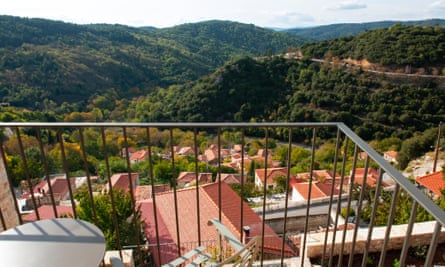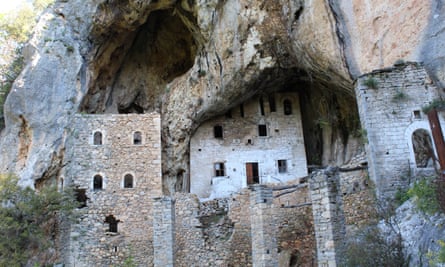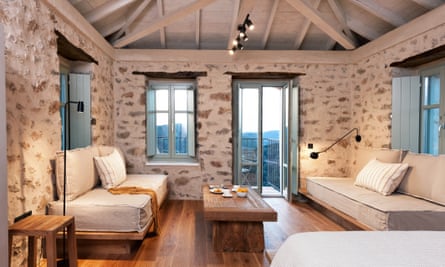At first glance, Vamvakou seems like many other mountain villages in the Peloponnese, with pretty, stone houses and cobbled streets fanning down to a large square. But Vamvakou is no ordinary village. In fact, it’s at the centre of an ambitious plan to revive the fortunes of Greek mountain villages, many of which are on the verge of extinction.
In 2016, Eleni Mami and her husband Anargyros Verdilos (who is from Sparta, but has roots in the village) were holidaying in Vamvakou when they decided they wanted to do something to stop the village’s seemingly inevitable death. In summer, the village was a hive of activity when the Vamvakite diaspora descended on their ancestral homes. But during winter, only nine older residents remained, custodians of a village that, like so many in Greece, was slowly but surely disappearing.
“We didn’t want that to happen, we wanted to resist,” says Eleni, when I meet her at Vamvakou after a three-hour drive from Athens.

The village might have been in decline, but one piece of good fortune was to help Eleni in her quest. Vamvakou was the birthplace of the parents of Stavros Niarchos, a billionaire Greek shipping tycoon, who bequeathed his fortune to his namesake foundation when he died in 1996. Eleni approached the foundation in 2017 with her proposal for turning Vamvakou from a dying summer retreat into a sustainable working village that would attract new residents, as well as visitors.
The application was a success – and walking through Vamvakou today, you begin to get a sense of the sheer scale of the multi-million dollar project’s ambition that is coming to life. Old stone mansions have been restored into both guesthouses and homes. Ruga of Vamvakou Homes is made up of three restored buildings with six rooms blending traditional architecture with chic design, while Vamvakou Traditional Guesthouse makes a simple, comfortable base. The village restaurant and cafe have been revamped and reopened. Agricultural co-operatives have been set up to support the village’s only extant economy – small-scale farming – and high-speed wi-fi has been installed.

“Two years ago, all we had was a church. Now this,” says Eleni as we climb the steep lanes to the village school. The school, which had shut in 2008 when the last student graduated, has not just been restored, but transformed into a hi-tech cultural centre and co-working space, complete with state-of-the-art facilities, including 3D printers, a science laboratory and a brand-new football pitch and basketball court. The whole thing seems so absurdly out of proportion – this is, after all, a remote village school that hasn’t had a student in 14 years – that I have to laugh.
But Eleni is deadly serious. “We want to make Vamvakou a centre of science and technology, as well as a retreat for conferences,” she says. “During the lockdown, we had many Vamvakites from Athens and the US come here to work remotely, taking advantage of our rural location and modern facilities.
“We are interested in attracting tourists year-round and have a full programme of various events every weekend. We would love people to experience Vamvakou as an authentic village and perhaps even stay long term. Ultimately, our primary objective is to create residents.”

At the newly restored Voureiko restaurant we are treated to a rustic lunch of spanakopita, beetroot salad with honey-roasted walnuts, trahanoto (a kind of Greek barley pasta), as well as a platter of meats and cheeses. The food is incredibly fresh, the result of the new agro co-op, but served with a certain panache that is unexpected here in the Greek boondocks. It turns out that the young chef, Stavros Georgantas, is a returnee. Born in Sparta to Vamvakite parents, he studied at one of the country’s best culinary schools before deciding to make the move back to his ancestral home.
After lunch, Eleni takes me on a walk to explore some of the village’s hiking trails. Even by the standards of rural Greece, there’s something particularly striking about the Parnon mountains and its handful of reclusive villages weaved into the steep, forested terrain. Beautiful and unspoilt, much of the area is a Natura 2000 zone, which has restricted any kind of development here and makes it great for stargazing.

From Vamvakou, it’s only a 40-minute drive to Sparta, with its ancient ruins and archaeological museum, and 50 minutes to the Unesco world heritage site of Mystras. The pretty beach towns of Paralio Astros and Gytheio are around 90 minutes away, and the Mani peninsula, one of Greece’s most up-and-coming destinations, is close by. All this means that Vamvakou works well for visitors looking for a mountainous getaway, combined with the coast and other historic sites.
As well as striving to create permanent jobs in the agricultural sector, promoting eco-tourism, and establishing the village as a remote-working technology and science hub, Vamvakou Revival has a wider remit and aims to help other rural areas develop sustainable, regenerative projects. Recently, the team started a business incubator to encourage young people from the surrounding area to initiate projects instead of just moving to Athens or abroad – and individuals and businesses are being invited to apply for support from the foundation.

With more people abandoning cities and looking for a simpler more grounded life in rural areas since the pandemic, the team hope Vamakou can work as a model to be be replicated elsewhere.
It’s early days and change will take time. Since the project started, the population of Vamvakou has risen from 9 to 21. Eleni and her husband have moved here permanently and just had their first child – the first birth in the village in 30 years. “One day, he’ll be a student at the school here,” says Eleni. “And he won’t be alone.”
For more information visit Vamvakou Revival project
Stay connected with us on social media platform for instant update click here to join our Twitter, & Facebook
We are now on Telegram. Click here to join our channel (@TechiUpdate) and stay updated with the latest Technology headlines.
For all the latest Lifestyle News Click Here
